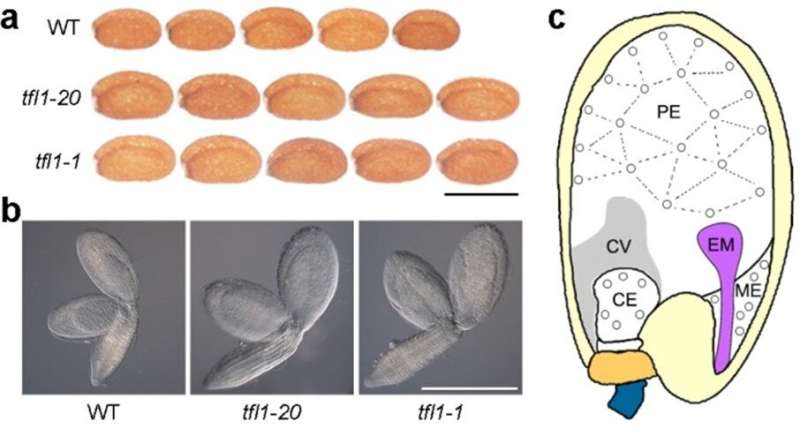Figure shows that the loss-of-function mutants, tfl1-1 and tfl1-20, exhibit an obvious large seed phenotype (panel a), which is associated with an increased size of the mature embryo (panel b). Panel c is the schematic representation of a developing Arabidopsis seed. CE, chalazal endosperm; CV, central vacuole; EM, embryo; ME, micropylar endosperm; PE, peripheral endosperm. Circles in ME, PE and CE represent endosperm nuclei. Credit: Nature Plants (panels a and b); Bin Zhang (panel c)
NUS biologists discovered the mobile TERMINAL FLOWER1 (TFL1) protein as an essential molecular switch for regulating endosperm development and seed size.
Seed development determines plant evolutionary fitness and crop yield in flowering plants. Among various growth parameters of seed development, seed size is an essential agronomic trait during domestication and breeding in many crops. Knowledge about seed size control in the model plant Arabidopsis thaliana provides insights into molecular breeding for crop improvement. This is part of ongoing efforts to address the increasing risk of food crises throughout the world.
A research team led by Prof Yu Hao from the Department of Biological Sciences, NUS has discovered a key regulator, TFL1, which serves as a hitherto unknown mobile signal that could respond to the uptake of maternal signals in the endosperm to determine the size of progeny seeds.
Fertilization in flowering plants results in an embryo and the surrounding endosperm, a nutrient-rich tissue that provides nourishment to the developing embryo. The endosperm is spatially divided into three domains, including micropylar, peripheral and chalazal endosperm. Cellularisation (a process of separation into distinct cells) of the micropylar and peripheral endosperm terminates the proliferation of the endopsperm, which governs the volume of seed cavity for the embryo enlargement and controls the final seed size.
Notably, the chalazal endosperm, which is close to maternal vascular tissues, is the only part of the endosperm that does not form distinct cells during seed development. The researchers found that TFL1 is a novel mobile regulator generated in the chalazal endosperm, which moves to the peripheral endosperm to control seed size under the regulation by a group of small GTP-binding Ras-related nuclear proteins. In the peripheral endosperm, TFL1 stabilizes an abscisic acid pathway regulator ABI5, thus mediating the timely separation of distinct cells of the endosperm and the final seed size.
Prof Yu said, "The global food crisis affects people in every corner of the world. More than 100 million people worldwide are facing acute levels of hunger. The COVID-19 pandemic could push even more families into severe food insecurity. Future climate change-driven shocks may also lead to more challenges."
He added, "Edible seeds, such as cereal grains, are the the dominant source of human calories and protein. The seed size of TFL1 loss-of-function Arabidopsis mutants is notably increased by 30% compared to that of wild-type seeds, suggesting TFL1 as a key molecular switch for seed size control. The biotechnological application of our findings is opening up a new avenue to improve crop yield and promote vegetation vigour in food crops. Big seeds not only increase seed biomass, but also store more nutrients for seedling growth."
More information: Bin Zhang et al. Mobile TERMINAL FLOWER1 determines seed size in Arabidopsis, Nature Plants (2020). DOI: 10.1038/s41477-020-0749-5
Journal information: Nature Plants
Provided by National University of Singapore























